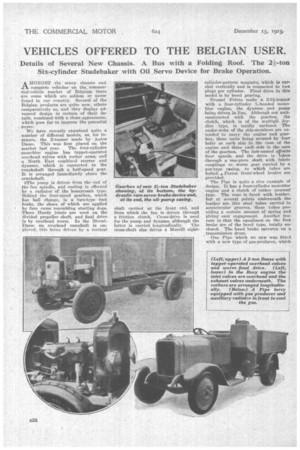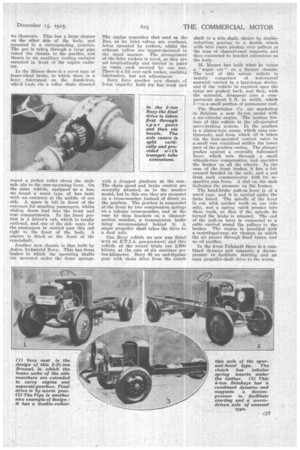VEHICLES OFFERED TO THE BELGIAN USER.
Page 10

Page 11

If you've noticed an error in this article please click here to report it so we can fix it.
Details of Several New Chassis. A Bus with a Folding Roof. The 2i-ton Six-cylinder Studebaker with Oil Servo Device for Brake Operation.
AMONGST the many chassis and complete vehicles' on the, commercial-vehicle market of Belgium there are come which are seldom or never found in our country. Several of the Belgian products are quite new, others comparatively so, and they display advanced design in certain of their details, combined with a clean.appearauce, which goes far to impress the potential buyer.
We have recently examined quite a number of different models, as, for instance, the 2-tonner made by Autos Dasse. This was first placed on the market last year. The four-cylinder monobloc engine has tappet-operated overhead valves with rocker arms, and a North East combined starter and dynamo, which is connected to the crankshaft through a half-speed gear. It is arranged immediately above the crankshaft.
The pump _is driven from the end of the fan spindle, and cooling is effected by a radiator of the honeycomb type. Behind the four-speed gearbox, which has ball change, is a loco-type foot brake, the shoes of which are applied by face rams resembling starting dogs. Three Hardy joints are used on the divided propeller shaft, and final drive is by overhead worm. In the 30-cwt. Dasse an overhead camshaft is employed. this being driven by a vertical shaft carried at the front end, and from which the fan is driven through a friction clutch. Cross-drive is used for the pump and dynamo, although the latter is carried longitudinally. The cross-shaft also drives a Marelli eight
cylinder-pattern magneto, which is carried vertically and is connected to two plugs per cylinder. Final drive in this model is by bevel gearing.
Brossel Freres make a 2-2i-touner with a four-cylinder L-headed monobloc engine, the dynamo and pump being driven in line. Although not unitconstructed with the gearbox, the clutch; which is of the Multiple drydisc type, is totally enclosed. The under-webs of the side-members are extended to carry the engine and gearbox, these units being secured by four bolts at each side in the case of the engine and three each side in the case of the gearbox. The last-named affords four speeds, and the drive is Taken through a one-piece shaft with fabric couplings to worm gear carried by a pot-type easing, to which tubes are bolted. , Perrot front-wheel brakes are provided.
The Pipe is quite a nice example of design. It has a four-cylinder monobloc engine and a clutch of rather unusual type. The cone is faced with leather, but at several points underneath the leather are thin steel tubes carried in semicircular grooves, these tubes proViding a certain amount of spring and giving easy engagement. Another feature is that the equalizers on the foot brake are of the bevel type, totally enclosed. The hand brake operates on a _ transmission drum. One Pipe which we saw was fitted with a new type of gas-producer, which we illustrate. This has a large cleaner on the other side of the body, and mounted in a corresponding position. The gas is taken through a large pipe round the chassis to the purifier, and thence to an auxiliary cooling radiator mounted in front of the engine radiator.
In the Miesse there is a novel type of front-wheel brake, in which there is a lever fulcrumed on the dumb-iron, which leads via a roller chain directed round a jockey roller above the stubaxle pin to the cam-operating lever. On the same vehicle, equipped as a bus, we found a novel type of bus body with an entrance at the middle of one side. A space is left in front of the entrance for standing passengers, whilst sliding doors lead into the front and rear compartments. In the front portion is a driver's cab, which is totally enclosed, and one of the side seats for the passengers is carried past this cab right to the front of the body. A starter is fitted at the front of the crankshaft.
Another new chassis is that built by Autos. Industrial Bovy. This has front brakes in which the operating shafts are mounted under the front springs. The engine resembles that used on the Rea, as its inlet valves are overhead, being operated by rockers, whilst the exhaust valves are tappet-operated in the usual manner. The arrangement of the inlet rockers is novel, as they are set longitudinally and carried in pairs in cases, each secured by one nut. There is a lid over each rocker, enabling lubrication, but not adjustment.
Bovy have another new chassis of 5-ton capacity built for Tins work and with a dropped platform at the rear. The chain speed and brake control are centrally situated, as in the smaller model, but in this one they are mounted on a cross-member instead of direct on the gearbox. The gearbox is suspended at the front by two compression springs on a tubular cross-member, and at the rear by drop brackets on a channelsection member, a transmission brake being accommodated behind it. A single propeller shaft takes the drive to a dual axle.
One Davy vehicle we saw was fitted with an E.T.I.A. gas-producer, and this vehicle at the recent trials ran 200 kiloms. at the rate of six centimes per ton-kilometre. Envy fit an end-tipping gear with chain drive from the clutch shaft to a side shaft, thence by doublereduction, gearing to a double winch with wire ropes passing over pulleys at the tops of channel-steel supports, and then connected to bracket extensions on the body.
M. Pilasset has built what he terms a "super car" on a Saurer chassis. The roof of this saloon vehicle is mainly comprised of waterproof material carried by a lazy-tongs device, and if the vehicle be required open the tongs are pushed hack, and they with the material, disappear into a compartment about 3 ft. in width, which a small portion of permanent roof.
The Studebaker Co. are marketing in Belgium a new 2i-ton model with a six-cylinder engine. The leading feature of this vehicle is the oil-operated servo-braking system. In the gearbox is a pinion-type pump, which runs continumisly, and from which oil is taken via the foot-operated control valve to a small ram contained within the lower part of the gearbox casing. The plunger pushes against a centrally fuIcrumed lever, which acts through a small whipple-tree compensator, and operates the brakes on all the wheels. In the case of the front brakes, it has a fulcrumed bracket on the axle, and a rod from each communicates with its respective cam lever. A dial on the dash indicates the pressure on the brakes.
The hand-brake pull-on lever is of a novel type, and it is carried under the facia board. The spindle of the lever is cut with ratchet teeth on one side only, and a spring catch presses into these teeth, so that if the spindle be turned the brake is released. The end of the pull-on lever is connected to a cable carried round the pulleys to the brakes. The engine is provided with a centrifugal-type air cleaner, in which the air passes through fixed vanes, and an oil purifier.
In the 4-ton Delahafe there is a combined dynamo and magneto, a decompressOr to facilitate starting and an open propeller-shaft drive to the worm.




























